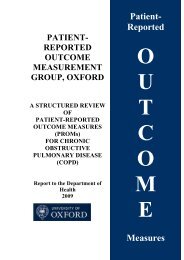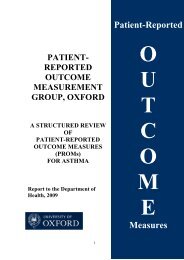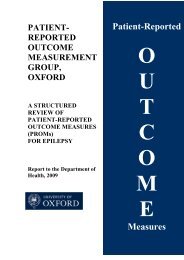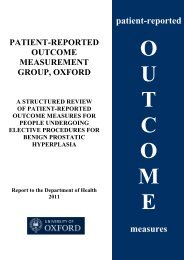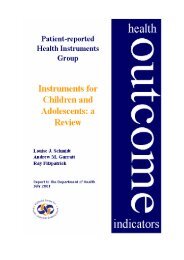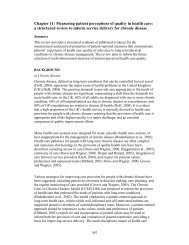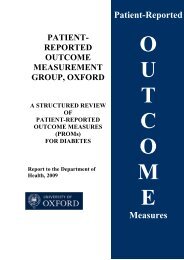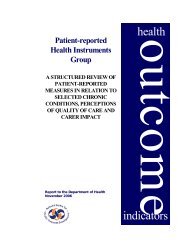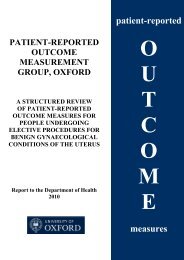2010 review - Patient-Reported Outcomes Measurement - University ...
2010 review - Patient-Reported Outcomes Measurement - University ...
2010 review - Patient-Reported Outcomes Measurement - University ...
You also want an ePaper? Increase the reach of your titles
YUMPU automatically turns print PDFs into web optimized ePapers that Google loves.
Heart disease in the UK<br />
Coronary heart disease (CHD) is the commonest cause of premature death in the UK; it is<br />
therefore a major priority for the UK government both to prevent the condition from<br />
developing, and to reduce the suffering and risk of death entailed by CHD (Department of<br />
Health, 2000). The National Strategic Framework for Coronary Heart Disease has set a<br />
number of standards for combating the impact of CHD; these include increasing the number<br />
of surgical revascularisation procedures carried out, and a reduction in waiting times,<br />
entailing major investment in services (Department of Health, 2000). Measuring patientreported<br />
outcomes should clearly be a key component in assessing the effectiveness of this<br />
strategy.<br />
Coronary revascularisation<br />
The term ‘coronary revascularisation’ encompasses both medical and surgical treatment for<br />
coronary artery disease (CAD). This <strong>review</strong> will examine the use of PROMs in relation to the<br />
most common elective procedures for CAD, namely coronary artery bypass grafting (CABG)<br />
and percutaneous coronary intervention (PCI) – also known as balloon angioplasty, coronary<br />
angioplasty, or percutaneous transluminal coronary angioplasty (PTCA).<br />
Coronary artery bypass grafting<br />
Coronary artery bypass grafting (CABG) is an elective surgical procedure to relieve angina<br />
and reduce the risk of death in patients with CAD whose coronary arteries are severely<br />
narrowed or blocked, restricting blood supply to the heart muscle. A vein or artery from<br />
elsewhere in the body (often one of the internal thoracic arteries, or the great saphenous vein<br />
from the leg) is used to form a graft, creating an alternative route around the damaged area.<br />
CABG is open heart surgery, usually performed with the heart stopped, necessitating the use<br />
of cardiopulmonary bypass (CPB). Since the mid-1990s, there has been a steady increase in<br />
the number of CABG procedures performed on a beating heart; this is known as ‘off-pump’<br />
surgery. In recent years, a less invasive procedure has been developed, namely, minimally<br />
invasive or direct coronary artery bypass (MIDCAB), suitable for patients with stenosis of the<br />
left anterior descending coronary artery (LAD). This procedure involves making an incision<br />
in the left chest, retracting the ribs and harvesting the left internal thoracic artery (LITA) to<br />
make a graft for the LAD; MIDCAB can be performed ‘on-’ or ‘off-pump’. Just over 20,000<br />
CABG procedures using thoracic artery grafts were performed in the UK in 2007-8 1 .<br />
Percutaneous coronary intervention<br />
In the past 20 years, the use of percutaneous coronary intervention (PCI) to treat patients with<br />
CAD in the UK has increased steadily, and the number of procedures carried out is now more<br />
than double the number of CABGs – over 50,000 in 2007-2008 2 . PCI can be an elective or an<br />
emergency procedure, and is used primarily to relieve symptoms. It involves the insertion of<br />
a catheter into a narrowed or stenotic section of a coronary artery, usually via a femoral<br />
artery; a balloon is then inflated to widen the stenosed area. A wire mesh tube or stent is often<br />
left in place to maintain the patency of the vessel; in suitable cases, medically coated or<br />
‘drug-eluting’ stents may be used to prevent restenosis and/or an inflammatory reaction to the<br />
stent. PCI is far less invasive and traumatic for the recipient than the open heart surgery of<br />
CABG; however, it is unclear whether long-term results offer any advantage over optimal<br />
1 See Hospital Episode Statistics, Headline figures 2007-8 at<br />
http://www.hesonline.org.uk/Ease/servlet/ContentServer?siteID=1937&categoryID=193<br />
2 As above.<br />
4





